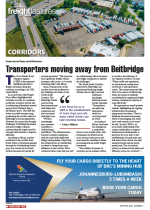Data networks built alongside Africa’s main trade routes are enabling the establishment of “smart corridors” which use a combination of GSM cell phone and satellite signals to manage the f low of cargo.The modernisation of manufacturing, agriculture and retail operations, and the live tracking and tracing of cargo follow connectivity.Mobile operators have helped Africa to leapfrog the landline era by providing the wireless networks needed for the Internet of Things (IoT) and artificial intelligence (AI). The GSMA's Mobile Economy Sub-Saharan Africa 2024 report puts mobile Internet penetration in sub-Saharan Africa at 27% in 2023. It is expected to reach 37% by 2030.More importantly for the logistics sector is that 4G adoption is expected to reach 50% by 2030, overtaking 3G as the primary technology.Technologies such AI, 5G and satellite could unlock $170 billion in GDP by 2030, according to the GSMA.By 2030, the continent is expected to have over 50 million licensed cellular IoT connections, with South Africa accounting for over half the total, according to the report.Support for the evolution of smart corridors is being provided by The European Union's Global Gateway initiative.The objective is to integrate the African and European multimodal transport networks in line with the regional and continental frameworks and tailor these networks to develop the economic potential of the AfCFTA by 2030. The Global Gateway corridors are Durban to Lubumbashi; Maputo to Walvis Bay and Lüderitz Bay; Abidjan-Lagos, Abidjan – Ouagadougou; Praia to Dakar-Abidjan; Cotonou – Niamey; Libreville/Kribi/Douala – N’Djamena; Douala/Kribi-Kampa; Dar es Salaam – Nairobi – Addis Ababa – Berbera/Djibouti; Mabasa – Kisangani; Cairo – Khartoum – Juba – Kampala and the Lobito Corridor. Each of the corridors will benefit from Global Gateway investment in hard infrastructure of up to EUR 100 million in grants for blended finance, with a potential for EUR 1bn leveraged from European Development Finance Institutions and the private sector.Soft infrastructure connectivity measures would potentially amount to EUR 25m in grant funding per corridor “to ensure sustainable, efficient, smart, resilient, fair, affordable, secure and safe mobility and trade within southern Africa, and between Africa and Europe”, according to the secretariat. ER

